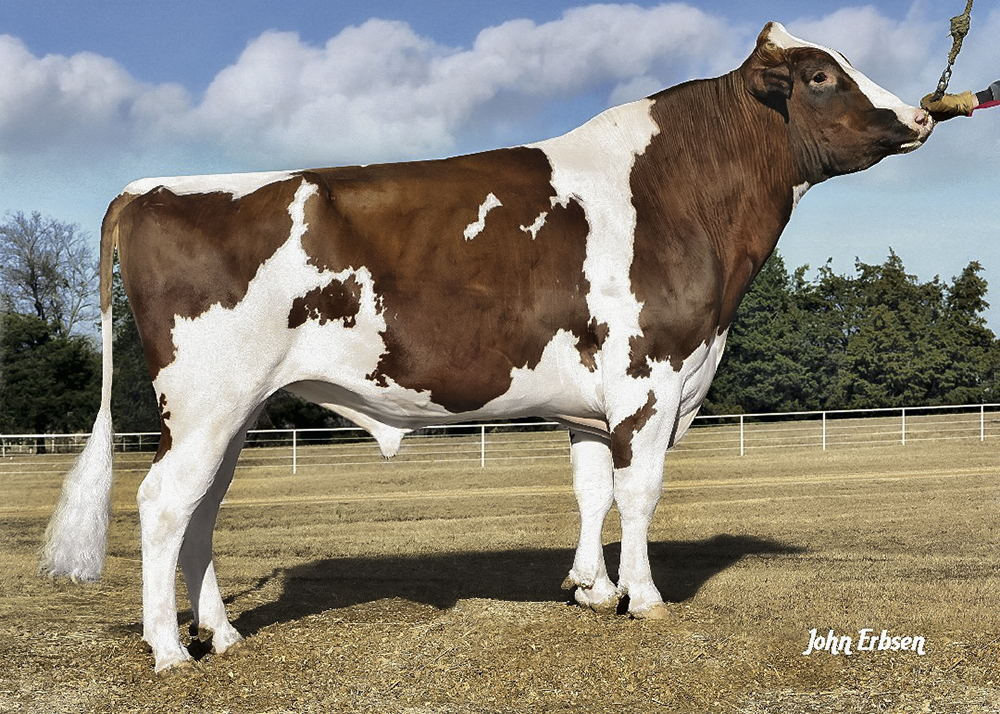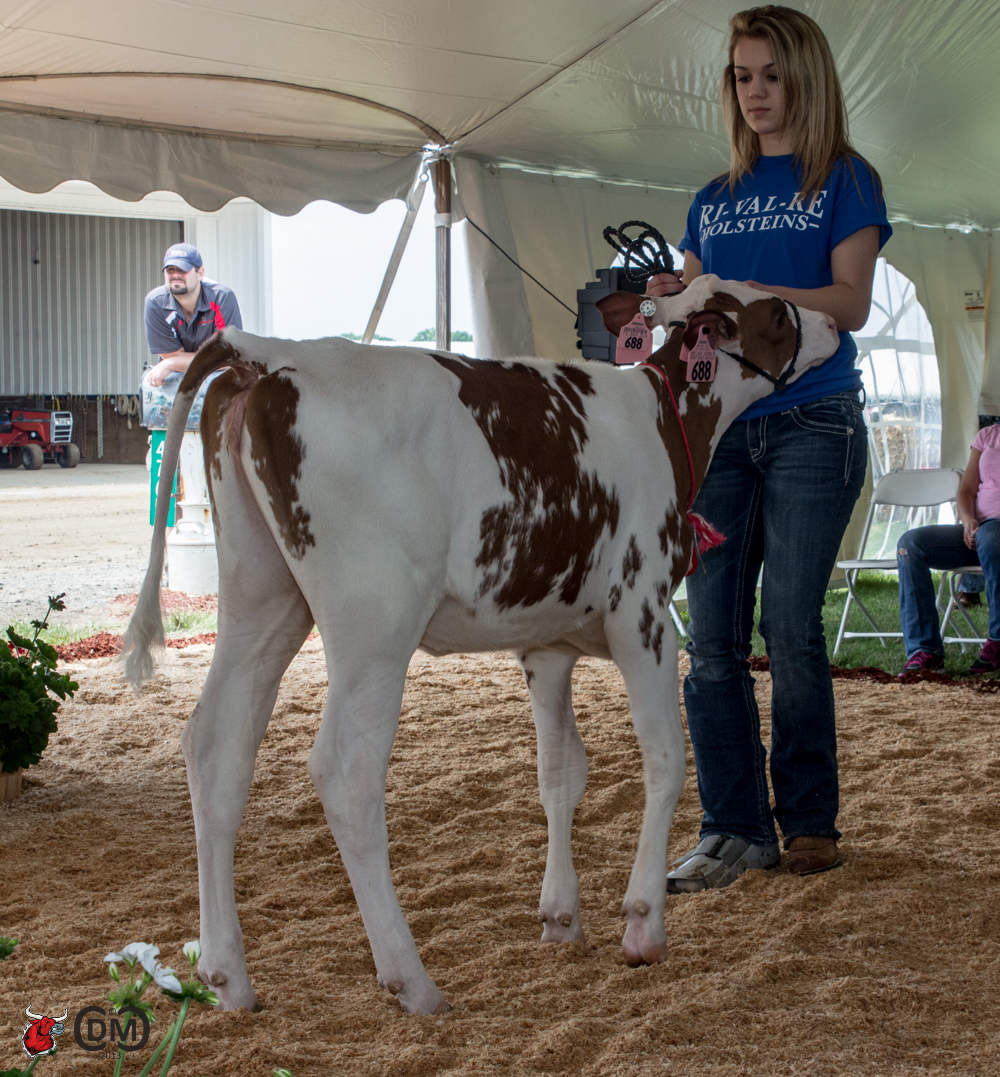Until recently, if you were talking about polled dairy genetics you were talking about a minor portion of the breeding population. However, modern dairy genetics has seen dramatic changes in that situation. The rising popularity of polled has been propelled in part by activists, consumers and breeders all of whom are seeking better ways to provide healthy products to the marketplace in an efficient, profitable and sustainable manner. Polled is a proactive opportunity to solve issues and meet needs in one genetic swoop.
Polled Pioneers Past and Present
Polled pioneer breeders have been few and far between. Thirty-nine years ago Burkett Falls Farm (Father Dave & Son John Burket, East Freedom, Pennsylvania, USA) had an Elevation daughter born, Sophie EX93, from which the majority of today’s polled Holsteins trace. The desire of breeders to have polled Holsteins until now has remained just that, a desire. Some polled bulls have entered AI but except for Aggravation Lawn Boy P-Red (born in 2002) few have gained much attention. Perhaps two reasons for that are that polled may have been associated with breeder proven bulls, known for unreliable single herd proofs, and a frequent association between polled and Red & White, which in North America represents only about 5% of the Holstein population.

Aggravation Lawn Boy P-Red (EX-93-GM)
Changing Polled Perceptions
On the one hand, the dominance of the polled trait in beef cattle has given rise to the false impression that polled Holsteins are descendant of a beef background. Today’s DNA testing capabilities answer that concern. However, despite this, the attitude of leading edge breeders is changing. No longer is the approach, stated in 1964 by the then Holstein Canada CEO George M Clemons, ‘we have other more important traits to improve’, in line with current breeders’ thinking. Today, having doubled the 1964 production levels, breeders want to avoid unpleasant work, unnecessary costs and raise a positive animal welfare reputation.
Polling for Dollars
Just last month at the Ri-Val-Re Sale, in Michigan, Bomaz Numero Uno 5904 PC (Numero Uno x Lawn Boy P-Red x Laudan x Garter), the #3 TPI™ polled heifer in the breed at 2365, sold for $(US) 215,0000. (Read more: Ri-Val-Re Select Sale Averages an Outstanding $25,910) Polled has come of age. Not only is Uno 5904 high indexing for fat, protein, mammary systems, productive life, daughter fertility, milking speed and milking temperament but she is also an outcross. In the same sale Ri-Val-Re The Best P-Red, the #1 TPI™ & NM$ female in the breed (Special Effect P-Red x Macguiness x Advent-Red x Ranger x Factor) sold for $(US) 38,000. Again an outcross to Oman, Goldwyn, Shottle, Bolton and Planet. Their buyers obviously have plans. Polled also made the headlines last fall when five doses of semen sold for $50,000 (Read more: $10,000 a dose Polled Semen). It was five doses of semen and the right to exclusivity of use for a few months of the homozygous polled bull Kulp-Dale Golden PP-Red (Colt-P x Goldwyn x Redman x Perk-Red x Rubens).

Ri-Val-Re The Best P-Red, the #1 TPI™ & NM$ female in the breed (Special Effect P-Red x Macguiness x Advent-Red x Ranger x Factor) sold for $(US) 38,000 at the Ri-Val-Re Select Sale.
Going Down the Polled Road
There are two ways to use polled in a herd’s breeding program when it comes to sire selection. One way is to go all out and only use PP bulls. All heifers born will be polled. The limiting factor will be that the heifers will not be as high for gTPI™, gLPI or NM$ as using P bulls (heterozygous for polled)
The alternative method would be to use P bulls. In the first generation half the heifers will be polled and in the second generation 25% will be homozygous polled, 50% will be polled but heterozygous and 25% will be horned. Definitely a slower route but the heifers will be higher indexing than using PP bulls.
More Bulls Are Polled Apart
The rise in polled popularity goes beyond two top selling heifers and five doses of semen. A search of the CDN files of Black & White polled bulls waiting to be old enough to be sampled, shows six bulls born in later 2012 and seven born and registered already in 2013 over +2750 LPI. Two are over +3000 LPI. Note that, on the CDN files, bulls cannot get a gLPI or have a DGV LPI listed until they are one year of age, These thirteen young bulls are the result of breeders breeding their top indexing females to polled bulls. As more and more top gTPI™ and gLPI cows and heifers are flushed to top polled bulls, 2500 gTPI™ young bulls and heifers will only be a short time down the road.
How to Pick Up Speed On the Polled Road

Roy MacGregor of DairyBullsOnline
It is always wise to ask questions and follow advice of the experts in new procedures. shares his insights on where to start when establishing polled genetics in your herd (Read more: They`re Sold On Polled!!). “The first procedure is to check for horn bud. If no bud do not dehorn. If after 3-4 weeks no horn bud develops your animal is likely polled. Another really good indicator is double eyelashes. A smooth head and double eyelashes should mean polled right away. Some calves and especially males can develop small immature buds or scurrs much later at 4-6 months or even older. In this case testing your calf with the German test or the UC Davis test is the best idea to avoid confusion.” He offers this encouragement “
There is a small learning curve but after a breeder gets a couple polled calves he will understand that smooth (like glass smooth) means polled, and it will get easier from there. “
Polled Procedures or “When in doubt, test!”
The test currently used through Holstein is the Igenity test, which we are told is accurate to 95% which is really quite good however we are all aware of the bulls Shine, and Balti being the exception. The most accurate test today is the German or UC Davis test closer to 99.9% or greater. However nothing can be said to be 100% because in genetics natural mutations can, and do occur. It should be noted no polled test can save poor management of mixed up hair samples. Of course, to err is human but when in doubt, test. For Homozygous calves obviously the only way to know is either wait until several offspring are born polled from one horned parent, or test. However in today’s day and age nobody wants to wait so we simply have to trust the best test at our disposal.
Is Polled Suffering from a Bad Code
Firstly the POC code currently in place naturally tends to lead some to believe there are “polled carriers” which only confuses the matter even more. There is no such thing as a “Polled carrier” animals are either polled or horned. Roy MacGregor, offers this opinion. “I think giving a dominate trait a recessive code is the wrong approach. It would be simpler to add P or PP right in the name. Nobody has to go looking for codes. It’s all right there right in the name, and with proper protocol at registration (simple pedigree research) and proper testing (when needed) this could easily be automatic.”
The Polled Learning Curve
For those who have been following some of the questions and concerns, MacGregor provides his viewpoint. “I think A.I’s all over the world have now panicked and realized all polled bulls need to tested at UC Davis, so the initial shock is probably over. However the problem now is what to do with all the females coded as POC on the 95% accurate Igenity test? This whole POC coding adventure has been especially frustrating for those who have been dealing with polled for years. Imagine being told you have to test something for POC that is obviously polled? Would you ask a breeder with a Red calf to test it for *RC? Polled is still fairly new so hopefully over time common sense will prevail, people just need to relax, slow down, and follow step one (check for the horn bud).”
The Bullvine Bottom Line
So, how do you see polled in your breeding program? Is it an opportunity? Is it an annoyance? Is it a necessity? The genetics are rapidly being established that mean there is no sacrifice in genetic merit if you breed for polled dairy cattle. The first choice of public opinion is moving quickly in favor of polled. From the sidelines, to headlines to main line it’s time to ask yourself, “When it comes to polled, what line will I commit to?”
Get original “Bullvine” content sent straight to your email inbox for free.
Other posts you might like:














